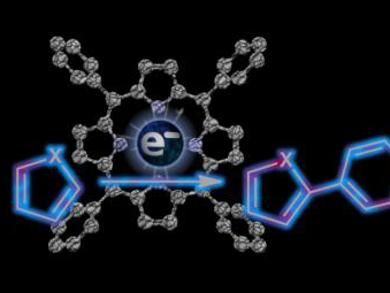Photoredox catalysis is strongly associated with Ru and Ir complexes. A recent list of metal-free photocatalysts only contains 33 compounds. Aromatic porphyrins, analogues of the natural photocatalyst chlorophyll, have been used to harvest light energy for, e.g., artificial photosynthesis, phototherapy, and imaging, and their electro- and photochemical properties offer opportunities for new photocatalytic reactions.
Dorota Gryko, Polish Academy of Sciences, Warsaw, Poland, and colleagues have developed a C–H arylation of N-, O-, and S-containing heterocycles with aryl diazonium salts (pictured) in the presence of a porphyrin catalyst and LED light with a wavelength of 455 nm. Screening experiments revealed the high importance of tuning the electro- and photochemical properties of the catalyst. An electron-poor pentafluorophenyl-substituted catalyst was found to be most efficient.
The C–H arylation with differently substituted phenyl diazonium salts was effective for furan, coumarin, and thiophene, while pyrrole derivatives proved to be more difficult to transform. According to the researchers, this might be attributed to porphyrin reacting faster with pyrrole than with the diazonium salt.
- Porphyrin-catalyzed photochemical C–H arylation of heteroarenes,
Dorota Gryko, Katarzyna Rybicka-Jasińska, Burkhard König,
Eur. J. Org. Chem. 2016.
DOI: 10.1002/ejoc.201601518




